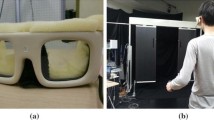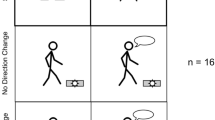Abstract
During adaptive locomotion, vision is used to guide the lead limb; however, the individual must rely on knowledge of obstacle height and position, termed obstacle memory, to guide the trail limb. Previous research has demonstrated that visual sampling of the obstacle during approach was adequate to provide obstacle height information, but online visual update of distance to the obstacle was required to plan and implement appropriate foot placement. Our purpose was to determine whether obstacle height memory, coupled with a visible obstacle position cue, could successfully guide the foot during obstacle crossing. Subjects first stepped over an obstacle for 25 trials; then, the obstacle was removed, but its position was marked with high-contrast tape; subjects were instructed to step over the obstacle as if it was still there (termed “virtual obstacle”) for 25 trials. No changes in foot placement were observed; therefore, the position cue provided salient online information to guide foot placement. Average failure rates (subject would have contacted the virtual obstacle if it was present) were 9 and 47 % (lead and trail limb, respectively). Therefore, action was impaired for both limbs when guided by obstacle height memory, but action was impaired to a greater extent for the trail limb. Therefore, viewing the obstacle during approach appears to facilitate the memory needed to guide obstacle crossing, particularly for the trail limb. This is likely because the lead limb is visible in the peripheral visual field during crossing, but the trail limb is not.





Similar content being viewed by others
References
Alexander MS, Flodin BW, Marigold DS (2011) Prism adaptation and generalization during visually guided locomotor tasks. J Neurophysiol 106:860–871
Amicuzi I, Stortini M, Petrarca M et al (2006) Visual recognition and visually guided action after early bilateral lesion of occipital cortex: a behavioral study of a 4.6-year-old girl. Neurocase 12:263–279
Anson JG, Burgess R, Scott RL (2010) Vision and movement planning. In: Elliott D, Khan MA (eds) Vision and goal-directed movement: neurobehav perspect. Human Kinetics, Champaign, pp 59–78
Berard JR, Vallis LA (2006) Characteristics of single and double obstacle avoidance strategies: a comparison between adults and children. Exp Brain Res 175:21–31
Berg WP, Blasi ER (2000) Stepping performance during obstacle clearance in women: age differences and the association with lower extremity strength in older women. J Am Geriatr Soc 48:1414–1423
Binsted G, Heath M (2005) No evidence of a lower visual field specialization for visuomotor control. Exp Brain Res 162:89–94
Binsted G, Rolheiser TM, Chua R (2006) Decay in visuomotor representations during manual aiming. J Mot Behav 38:82–87
Chen HC, Ashton-Miller JA, Alexander NB, Schultz AB (1991) Stepping over obstacles: gait patterns of healthy young and old adults. J Gerontol 46:M196–M203
Drew T, Andujar J-E, Lajoie K, Yakovenko S (2008) Cortical mechanisms involved in visuomotor coordination during precision walking. Brain Res Rev 57:199–211
Elliott D (1988) The influence of visual target and limb information on manual aiming. Can J Psychol 42:57
Gibson JJ (1958) Visually controlled locomotion and visual orientation in animals. Br J Psychol 49:182–194
Gibson JJ (1966) The senses considered as perceptual systems. Houghton Mifflin, Boston
Heath M (2005) Role of limb and target vision in the online control of memory-guided reaches. Motor Control 9:281–311
Heath M, Neely K, Krigolson O, Binsted G, Elliott D (2010) Memory-guided reaching: what the visuomotor system knows and how long it knows it. In: Elliott D, Khan MA (eds) Vision and goal-directed movement: neurobehav perspect. Human Kinetics, Champaign, pp 79–96
Heijnen MJH, Muir BC, Rietdyk S (2012a) Factors leading to obstacle contact during adaptive locomotion. Exp Brain Res 223:219–231
Heijnen MJH, Muir BC, Rietdyk S (2012b) Interpolation techniques to reduce error in measurement of toe clearance during obstacle avoidance. J Biomech 45:196–198
Kelly VE, Janke AA, Shumway-Cook A (2010) Effects of instructed focus and task difficulty on concurrent walking and cognitive task performance in healthy young adults. Exp Brain Res 207:65–73
Lajoie K, Andujar J-É, Pearson K, Drew T (2010) Neurons in area 5 of the posterior parietal cortex in the cat contribute to interlimb coordination during visually guided locomotion: a role in working memory. J Neurophysiol 103:2234–2254
Lajoie K, Bloomfield LW, Nelson FJ, Suh JJ, Marigold DS (2012) The contribution of vision, proprioception, and efference copy in storing a neural representation for guiding trail leg trajectory over an obstacle. J Neurophysiol 107:2283–2293
Lee DN, Lishman JR, Thomson JA (1982) Regulation of gait in long jumping. J Exp Psychol Hum Percept Perform 8:448–459
Loverro KL, Mueske NM, Hamel KA (2013) Location of minimum foot clearance on the shoe and with respect to the obstacle changes with locomotor task. J Biomech 46:1842–1850
McVea DA, Pearson KG (2006) Long-lasting memories of obstacles guide leg movements in the walking cat. J Neurosci 26:1175–1178
McVea DA, Pearson KG (2007) Stepping of the forelegs over obstacles establishes long-lasting memories in cats. Curr Biol 17:R621–R623
Milner AD, Goodale MA (1995) The visual brain in action. Oxford University Press, New York
Milner A, Dijkerman H, McIntosh R, Rossetti Y, Pisella L (2003) Delayed reaching and grasping in patients with optic ataxia. Prog Brain Res 142:225–242
Mohagheghi AA, Moraes R, Patla AE (2004) The effects of distant and on-line visual information on the control of approach phase and step over an obstacle during locomotion. Exp Brain Res 155:459–468
Niang A, McFadyen B (2004) Adaptations in bilateral mechanical power patterns during obstacle avoidance reveal distinct control strategies for limb elevation versus limb progression. Mot Control 8:160
Patla AE (1998) How is human gait controlled by vision. Ecol Psychol 10:287–302
Patla AE, Greig M (2006) Any way you look at it, successful obstacle negotiation needs visually guided on-line foot placement regulation during the approach phase. Neurosci Lett 397:110–114
Patla A, Rietdyk S (1993) Visual control of limb trajectory over obstacles during locomotion: effect of obstacle height and width. Gait Posture 1:45–60
Patla AE, Vickers JN (1997) Where and when do we look as we approach and step over an obstacle in the travel path? NeuroReport 8:3661–3665
Patla AE, Rietdyk S, Martin C, Prentice S (1996) Locomotor patterns of the leading and the trailing limbs as solid and fragile obstacles are stepped over: some insights into the role of vision during locomotion. J Mot Behav 28:35–47
Rhea CK, Rietdyk S (2007) Visual exteroceptive information provided during obstacle crossing did not modify the lower limb trajectory. Neurosci Lett 418:60–65
Rhea CK, Rietdyk S (2011) Influence of an unexpected perturbation on adaptive gait behavior. Gait Posture 34:439–441
Rhea CK, Rietdyk S, Haddad JM (2010) Locomotor adaptation versus perceptual adaptation when stepping over an obstacle with a height illusion. PLoS ONE 5:e11544
Rietdyk S, Rhea CK (2006) Control of adaptive locomotion: effect of visual obstruction and visual cues in the environment. Exp Brain Res 169:272–278
Rietdyk S, Rhea CK (2011) The effect of the visual characteristics of obstacles on risk of tripping and gait parameters during locomotion. Ophthalmic Physiol Opt 31:302–310
Shinya M, Popescu A, Marchak C, Maraj B, Pearson K (2012) Enhancing memory of stair height by the motor experience of stepping. Exp Brain Res 223:405–414
Siu K-C, Woollacott MH (2007) Attentional demands of postural control: the ability to selectively allocate information-processing resources. Gait Posture 25:121–126
Telonio A, Blanchet S, Maganaris C, Baltzopoulos V, McFadyen B (2013) The detailed measurement of foot clearance by young adults during stair decent. J Biomech 46:1400–1402
Thies S, Jones R, Kenney L, Howard D, Baker R (2011) Effects of ramp negotiation, paving type and shoe sole geometry on toe clearance in young adults. J Biomech 44:2679–2684
Warren WH (2006) The dynamics of perception and action. Psychol Rev 113:358–389
Whishaw IQ, Sacrey LA, Gorny B (2009) Hind limb stepping over obstacles in the horse guided by place-object memory. Behav Brain Res 198:372–379
Winter DA (2009) Biomechanics and motor control of human movement. Wiley, Hoboken
Yang JF, Lam T, Pang MYC, Lamont E, Musselman K, Seinen E (2004) Infant stepping: a window to the behaviour of the human pattern generator for walking. Can J Physiol Pharmacol 82(8):662–674
Yogev-Seligmann G, Rotem-Galili Y, Mirelman A, Dickstein R, Giladi N, Hausdorff JM (2010) How does explicit prioritization alter walking during dual-task performance? Effects of age and sex on gait speed and variability. Phys Ther 90:177–186
Author information
Authors and Affiliations
Corresponding author
Rights and permissions
About this article
Cite this article
Heijnen, M.J.H., Romine, N.L., Stumpf, D.M. et al. Memory-guided obstacle crossing: more failures were observed for the trail limb versus lead limb. Exp Brain Res 232, 2131–2142 (2014). https://doi.org/10.1007/s00221-014-3903-3
Received:
Accepted:
Published:
Issue Date:
DOI: https://doi.org/10.1007/s00221-014-3903-3




